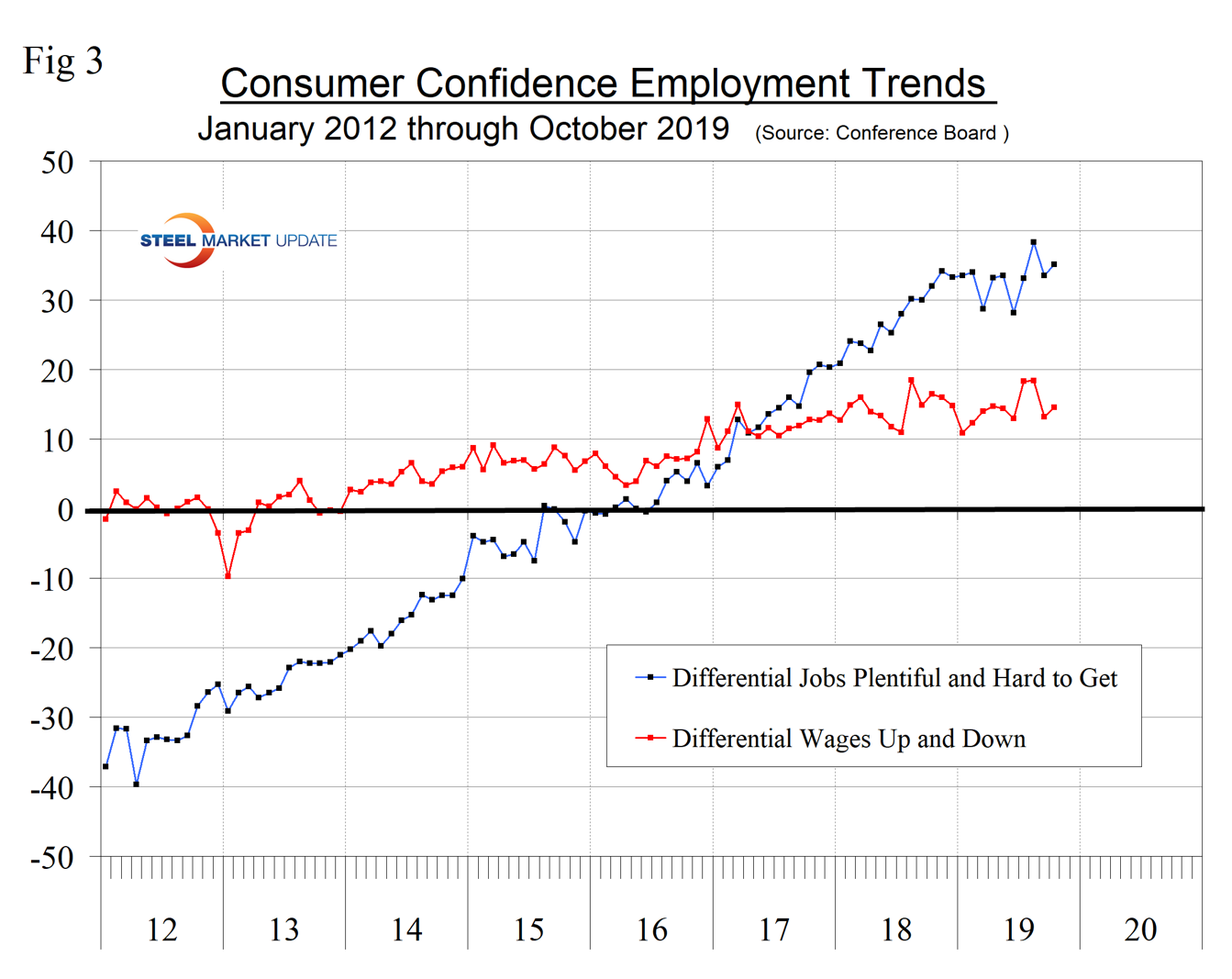Economy

Conference Board: Signs of Weakening in Consumer Confidence
Written by Peter Wright
October 1, 2019
Both the September and October reports on consumer confidence from The Conference Board suggest a weakening of people’s expectations.
Consumer confidence as reported by The Conference Board declined more than expected in September and experienced another small decline in October. This is quite a volatile indicator and therefore we smooth the data with a moving average to reduce monthly variability. The composite value of consumer confidence in October was 125.9 with a three-month moving average (3MMA) of 128.8. Month on month, the 3MMA decreased from 132.1 to 128.8. The composite index is made up of two sub-indexes: the consumer’s view of the present situation and his or her expectations for the future. In October, both consumers’ view of the present situation and their expectations were below the nine-year trend line (Figure 1).

Moody’s Analytics summarized as follows: “The Conference Board’s consumer confidence index fell short of both our and consensus expectations in October. The index fell from a revised 126.3 in September to 125.9 in October. Expectations declined from 96.8 to 94.9. Consumers’ assessment of present conditions improved, rising from 170.6 to 172.3. The labor market differential, or the difference between the share of respondents saying jobs are hard to get minus those saying jobs are hard to find, improved from September. Buying plans were mixed. Still, fundamentals remain solid for consumers, and they will be the key cog for the economy.”
The consumer’s view of the present situation in October was the highest since November last year. The 3MMA was the highest since January 2001. The 3MMA of expectations in October was 99.4, down from 105.2 in September and 105.5 in August. The historical pattern of the 3MMA of the composite, the view of the present situation and expectations since January 1990 are shown in Figure 2.

On a three-month moving average basis comparing October 2019 with October 2018, the 3MMA of the present situation was up by 1.6 points and expectations were down by 12.9 points (Table 1). The color codes show improvement or deterioration of the individual components in Table 1. July and August were the first months for the table to be all green since January 2018. By this measure there was a real deterioration in September and October.

The consumer confidence report includes employment data that is still encouraging as 46.9 percent of respondents reported jobs to be plentiful and 11.8 percent reported jobs hard to get. Expectations for wage increases were also positive, with 21.1 percent expecting an increase and 6.5 percent expecting a decrease (Figure 3).

Consumer spending measures in October indicated that year-over-year plans to buy a car declined to the lowest level since October 2015. Plans to buy an appliance have improved steadily this year but are still where they were in November 2017. Plans to buy a house have not made progress in three years (Figure 4).

SMU Comment: The Conference Board Consumer Confidence Index is a volatile measure and must be reviewed as a three-month moving average to obtain a realistic view of trends. Based on Table 1, the September and October results are indicating a declining level of optimism on the part of the consumer though he/she still thinks the present situation is good. Purchase plans for autos, houses and appliances all declined in October.
Steel demand is dependent on the growth of GDP, which in turn is strongly influenced by consumer confidence, disposable income and a willingness to spend; therefore, this report gives cause for concern.
About The Conference Board: The Conference Board is a global, independent business membership and research association working in the public interest. The monthly Consumer Confidence Survey®, based on a probability-design random sample, is conducted for The Conference Board by Nielsen. The index is based on 1985 = 100. The composite value of consumer confidence combines the view of the present situation and expectations for the next six months.

Peter Wright
Read more from Peter WrightLatest in Economy

ISM: Manufacturing expansion loses steam after two months of growth
US manufacturing activity slowed in March after two straight months of expansion, according to supply executives contributing to the Institute for Supply Management (ISM)’s latest report.

Chicago Business Barometer rose to 16-month high in March
The Chicago Business Barometer increased for the third-consecutive month in March. Despite this, it still reflects contracting business conditions, as it has since December 2023.

Durable goods orders rise again in February
Transportation equipment led the increase, rising 1.5% to $98.3 billion.

Consumer confidence falls for fourth consecutive month
People remain concerned about inflation, trade policies, and tariffs.

Housing starts ticked up in February
Single-family starts last month hit a rate of 1.10 million, a month-over-month increase of 11.4%, census data shows.
